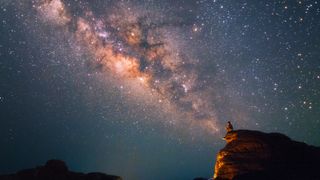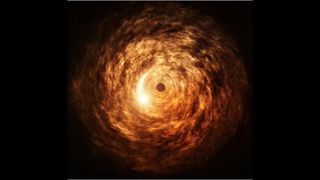Milky Way
Latest about Milky Way

James Webb Space Telescope discovers mysterious flares near the Milky Way's monster black hole
By Ben Turner published
Sagittarius A*, our galaxy's supermassive black hole, is constantly producing strange eruptions. Astronomers are using the James Webb Space Telescope to find out why.

Scientists discover giant galaxy 32 times bigger than Earth's — and they named it 'trouble'
By Jacinta Delhaize published
Scientists have discovered an enormous radio galaxy 32 times the size of the Milky Way. They nicknamed it "Inkathazo," or "trouble," as the team struggles to understand the physics behind it.

Milky Way quiz: How well do you know our home galaxy?
By Harry Baker published
Test your knowledge of the Milky Way's size, speed, age, galactic neighbors and more.

Supermassive black holes in 'little red dot' galaxies are 1,000 times larger than they should be, and astronomers don't know why
By Robert Lea published
"Our measurements imply that the supermassive black hole mass is 10% of the stellar mass in the galaxies we studied."

Mysterious 'ice balls' in space baffle astronomers
By Ben Turner published
Astronomers have discovered two strange objects that could be young stars — except they're completely surrounded by ice.

'Herculean' 2.5-billion-pixel mosaic shows our closest galactic neighbor like never before — and took more than a decade to create
By Harry Baker published
The new composite image, which combines hundreds of photos from the Hubble Space Telescope, shows the Andromeda Galaxy with more than 200 million individually resolved stars.

James Webb telescope captures 1st 'mid-infrared' flare from Milky Way's supermassive black hole
By Stephanie Pappas published
The James Webb Space Telescope has captured a mid-infrared picture of Sagittarius A*, filling in a long-standing gap in observations..

Most of the atoms in your body left the Milky Way on a 'cosmic conveyor belt' long before you were born, new study reveals
By Harry Baker published
New research suggests that most of the atoms within the human body likely spent part of their lives drifting beyond the Milky Way on a cosmic "conveyor belt," before eventually returning to our galaxy.

Scientists discover 2 stars dancing around the Milky Way's black hole — and they could point to a type of planet never seen before
By Sharmila Kuthunur published
Astronomers have discovered a pair of young stars near the supermassive black hole at the heart of our galaxy. Studying them can offer a rare glimpse into how stars can endure — at least briefly — the immense gravity exerted by such cosmic behemoths.

James Webb telescope spies stunning 'Firefly Sparkle' galaxy — a baby clone of the Milky Way being 'assembled brick by brick' in the early universe
By Harry Baker published
The James Webb Space Telescope has captured an image of a baby, Milky Way-like galaxy that formed more than 13 billion years ago. This "Firefly Sparkle" galaxy could reveal how our own galaxy evolved.
Sign up for the Live Science daily newsletter now
Get the world’s most fascinating discoveries delivered straight to your inbox.
